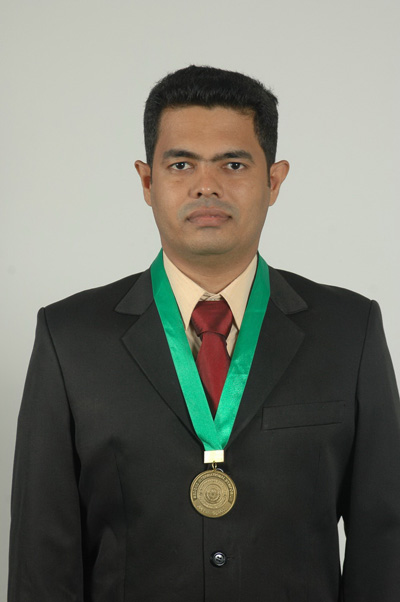
Asian Institute of Technology Ph.D. candidate Udaya
Rathnayaka, a student of food engineering and bioprocess
technology at the School of Environment, Resources and Development,
says he has found a better way to detect the deadly pathogen salmonella
found in chicken meat. Udaya’s peers would seem to agree. His academic
presentation on the topic won him top prize at a recent international
symposium organized by Sabaragamuwa University, Sri Lanka, from 8 - 12
July.
His presentation titled “Influence of antibiotic treatments on the
detection of viable salmonella enterica from inoculated
chicken samples by fluorescent in-situ hybridization” was based on
earlier doctoral conducted under the supervision of professor Sudip K.
Rakshit.
By finding the best and most reliable method to detect viable
salmonella, a food-borne bacterial pathogen found in chicken meat
products, Udaya won top honors in the symposium’s livestock production
category. His talk won out over twelve international presentations from
participants from across Asia. Udaya explains his central thesis: “In
the study, I compared samples of chicken meat by using the Normal
Fluorescent In-Situ Hybridization (FISH) Method with a Modified FISH
Method that I developed myself. I then found that the normal FISH
method cannot detect whether the salmonella in the chicken meat is
actually live or dead. The modified method detects only the living
cells. With my modified method, one can tell whether the meat contains
living salmonella or not.”
Udaya says food samples can contain live and dead salmonella cells. By
relying solely on the normal FISH method, differentiating live cells
from dead cells is very difficult. “My method adds one extra step to
this method—the antibiotic treatment step, which takes only 30 minutes
extra,” he says. “The process is quite fast and takes only seven hours
which is much quicker to that the methods currently available, which
normally take 2-3 days.”
Udaya said his research provides benefits to both consumers and the
manufacturers. He believes that by developing a rapid and reliable
process for the detection of live salmonella cells from food samples,
consumers will eventually be better protected from potential food
poisoning.
The process could also have application for the food processing
industry. Manufacturers can lessen the expenses they incur when forced
to discard food products containing only dead salmonella cells.
Applying this innovative approach, firms only need to discard meat
found to contain live salmonella cells. At present, when salmonella
can’t be detected, whether in live or dead cells, all meat in generally
thrown out as waste. Udaya claims his modified FISH method can save
many food manufacturers money. The modified method can be applied to
other kinds of food samples, and environmental samples can be analyzed
in this way for detection of microorganisms.
Currently Udaya is experimenting and comparing several other methods
used in the detection of food-borne microbial pathogens, studying which
one is optimal under different conditions. This study will form part of
his overall doctoral dissertation.
In receiving the outstanding paper presentation award, the former AIT
Student Union President was presented with a gold medal and certificate
of recognition. The award is well known in Sri Lanka and should boost
Udaya’s prospects to become a university lecturer. Following his
graduation from AIT in one year’s time, he plans to return home and
resume teaching at the university where he taught prior to enrolling.
He hopes to gain promotion as a senior level lecturer, eventually.
Udaya received a scholarship from his former university (with support
from the World Bank) and a partial fellowship from AIT.
http://www.srilankafirst.com/General/6539.html
http://www.thecolombotimes.com/
